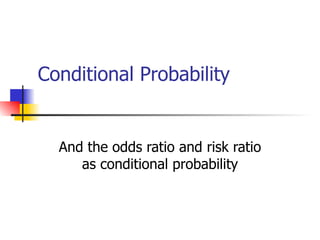
Lecture3
- 1. Conditional Probability And the odds ratio and risk ratio as conditional probability
- 4. U sing a probability tree Rule of thumb: in probability, “and” means multiply, “or” means add Mendel example: What’s the chance of having a heterozygote child (Dd) if both parents are heterozygote (Dd)? P( ♀ D=.5) P( ♀ d=.5) Mother’s allele P( ♂ D=.5) P( ♂ d=.5) P( ♂ D=.5) P( ♂ d=.5) Father’s allele ______________ 1.0 P(DD)=.5*.5=.25 P(Dd)=.5*.5=.25 P(dD)=.5*.5=.25 P(dd)=.5*.5=.25 Child’s outcome
- 6. On the tree P( ♂ D/ ♀ D )=.5 P( ♂ d=.5) P( ♂ D=.5) P( ♂ d=.5) Father’s allele P( ♀ D=.5) P( ♀ d=.5) Mother’s allele ______________ 1.0 P(DD)=.5*.5=.25 P(Dd)=.5*.5=.25 P(dD)=.5*.5=.25 P(dd)=.5*.5=.25 Child’s outcome Conditional probability Marginal probability: mother Joint probability Marginal probability: father
- 11. Answer ______________ 1.0 P (+, test +)=.0297 P(+, test -)=.003 P(-, test +)=.00097 P(-, test -) = .96903 P(test +)=.0297+.00097=.03067 P(+&test+) P(+)*P(test+) .0297 .03*.03067 (=.00092) Dependent! Marginal probability of carrying the virus. Joint probability of being + and testing + Marginal probability of testing positive Conditional probability: the probability of testing + given that a person is + P(+)=.03 P(-)=.97 P(test +)=.99 P(test - )= .01 P(test +) = .001 P(test -) = .999
- 12. Law of total probability One of these has to be true (mutually exclusive, collectively exhaustive). They sum to 1.0.
- 15. Example: Mammography P(BC/test+)=.0027/(.0027+.10967)=2.4% ______________ 1.0 P(test +)=.90 P(BC+)=.003 P(BC-)=.997 P(test -) = .10 P(test +) = .11 P (+, test +)=.0027 P(+, test -)=.0003 P(-, test +)=.10967 P(-, test -) = .88733 P(test -) = .89 Marginal probabilities of breast cancer….(prevalence among all 54-year olds) sensitivity specificity
- 16. Bayes’ rule
- 19. Bayes’ Rule: OR From the “Law of Total Probability”
- 22. Answer: using probability tree A positive test places one on either of the two “test +” branches. But only the top branch also fulfills the event “true infection.” Therefore, the probability of being infected is the probability of being on the top branch given that you are on one of the two circled branches above. ______________ 1.0 P(test +)=.99 P(+)=.03 P(-)=.97 P(test - = .01) P(test +) = .001 P (+, test +)=.0297 P(+, test -)=.003 P(-, test +)=.00097 P(-, test -) = .96903 P(test -) = .999
- 23. Answer: using Bayes’ rule
- 28. Conditional Probability for Epidemiology: The odds ratio and risk ratio as conditional probability
- 31. Odds vs. Risk=probability Note: An odds is always higher than its corresponding probability, unless the probability is 100%. 1:1 3:1 1:9 1:99 1/100 (1%) 1/10 (10%) ¾ (75%) ½ (50%) Then the odds are… If the risk is…
- 32. Cohort Studies (risk ratio) Target population Disease Disease-free Disease Disease-free TIME Exposed Not Exposed Disease-free cohort
- 33. The Risk Ratio Exposure (E) No Exposure (~E) Disease (D) a b No Disease (~D) c d a+c b+d risk to the exposed risk to the unexposed
- 34. Hypothetical Data 400 400 1100 2600 Normal BP Congestive Heart Failure No CHF 1500 3000 High Systolic BP
- 37. Hypothetical results: Smoker (E) Non-smoker (~E) Stroke (D) 15 35 No Stroke (~D) 8 42 50 50
- 38. What’s the risk ratio here? Tricky: There is no risk ratio, because we cannot calculate the risk of disease!! 50 50 Smoker (E) Non-smoker (~E) Stroke (D) 15 35 No Stroke (~D) 8 42
- 40. The Odds Ratio (OR) Luckily, you can flip the conditional probabilities using Bayes’ Rule: 50 50 These data give: P(E/D) and P(E/~D). Smoker (E) Smoker (~E) Stroke (D) 15 35 No Stroke (~D) 8 42 Unfortunately, our sampling scheme precludes calculation of the marginals: P(E) and P(D), but turns out we don’t need these if we use an odds ratio because the marginals cancel out!
- 41. The Odds Ratio (OR) Exposure (E) No Exposure (~E) Disease (D) a b No Disease (~D) c d Odds of exposure in the cases Odds of exposure in the controls
- 42. The Odds Ratio (OR) But, this expression is mathematically equivalent to: Backward from what we want… The direction of interest! Odds of disease in the exposed Odds of disease in the unexposed Odds of exposure in the cases Odds of exposure in the controls
- 43. = Proof via Bayes’ Rule Odds of exposure in the controls Odds of exposure in the cases Bayes’ Rule Odds of disease in the unexposed Odds of disease in the exposed What we want!
- 46. The rare disease assumption 1 1 When a disease is rare: P(~D) = 1 - P(D) 1
- 47. The odds ratio vs. the risk ratio 1.0 (null) Rare Outcome Common Outcome 1.0 (null) Odds ratio Risk ratio Risk ratio Odds ratio Odds ratio Risk ratio Risk ratio Odds ratio
- 51. Interpreting ORs when the outcome is common… Formula from: Zhang J. What's the Relative Risk? A Method of Correcting the Odds Ratio in Cohort Studies of Common Outcomes JAMA. 1998;280:1690-1691. Where: OR = odds ratio from logistic regression (e.g., 3.92) P 0 = P(D/~E) = probability/prevalence of the outcome in the unexposed/reference group (e.g. ~45%) If data are from a cross-sectional or cohort study, then you can convert ORs (from logistic regression) back to RRs with a simple formula:
- 52. For wrinkle study… Zhang J. What's the Relative Risk? A Method of Correcting the Odds Ratio in Cohort Studies of Common Outcomes JAMA. 1998;280:1690-1691. So, the risk (prevalence) of wrinkles is increased by 69%, not 292%.